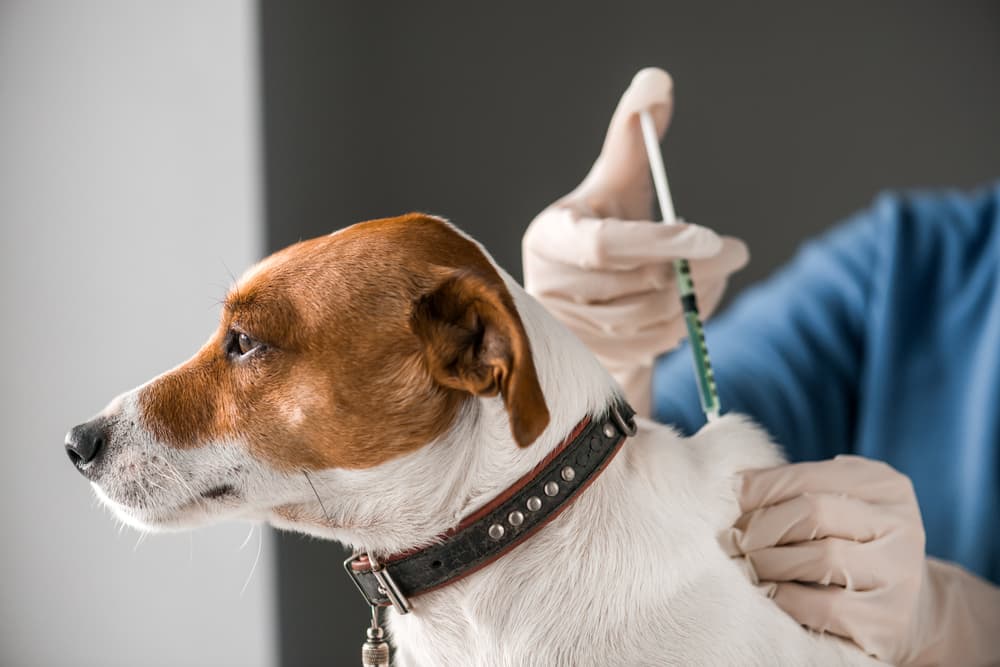Lyme Disease is a serious illness that can affect both humans and animals. It's transmitted by the bite of infected ticks, and poses a significant risk to our beloved pet dogs. To protect them, it's crucial that we know the symptoms, prevention methods, and treatments associated with Lyme Disease.

Ticks carrying the bacteria that causes Lyme Disease are found in wooded areas and tall grass. If a tick attaches itself and begins feeding on a dog's blood, it can spread the infection. Early signs of Lyme Disease may be hard to spot, such as lethargy, loss of appetite, and lameness. If left untreated, it can lead to more severe symptoms, such as joint pain, kidney damage, and neurological issues.
Preventing Lyme Disease starts with keeping our pet's environment clean and reducing their exposure to ticks. Regularly check them for ticks after outdoor activities, use preventive products recommended by veterinarians, and consider vaccinating your dog against Lyme Disease.
If you suspect your dog has Lyme Disease, seek veterinary care immediately. Diagnostic testing will determine whether your pet has been infected. Treatment typically involves antibiotic medication to eliminate the bacteria from the system.
To keep your furry friend safe and healthy, remember to stay informed about Lyme Disease and be proactive in preventing tick bites. Regular grooming and maintaining a tick-free yard are also key steps in guarding your pet's health.

What is Lyme Disease?
Lyme Disease, a tick-borne illness, is a threat to both humans and animals. Bacteria called Borrelia burgdorferi causes it and leads to symptoms such as fever, loss of appetite, and lameness in dogs. Preventing Lyme Disease is possible by taking certain measures.
To protect pets from this disease, regular tick checks are essential. Use tweezers or tick removal tools to remove ticks carefully. Veterinary-approved treatments such as topical solutions and oral medications can repel ticks.
Good hygiene is important for prevention. Grooming dogs helps detect ticks and keep their coats clean. Keep the environment tick-free and regularly clean living and sleeping areas.
Creating a tick-resistant yard helps protect your dog. Trim grass and shrubs, and put wood chips or gravel at yard boundaries to keep ticks out.
Prevalence of Lyme Disease in Dogs
Let's pay attention to Lyme Disease, a common condition in dogs. Here are some facts about the prevalence of Lyme Disease in dogs:
| Category | Percentage |
|---|---|
| Infected Dogs | 45% |
| Geographical Distribution | 68 states |
| Reported Cases | 10,000+ |
Apart from the high infection rate, it is essential to know that the disease is widespread across 68 states. Plus, over 10,000 cases have already been reported - indicating how urgent it is to address this issue.
Researchers first noticed Lyme Disease in dogs in 1984. Initially, they thought it was an exceptional case. Later, they discovered many more dogs were infected. This started extensive research and preventive measures for our furry friends.
We need to be aware of the prevalence of Lyme Disease in dogs, as it may cause severe health problems if not treated or recognized. By being knowledgeable and taking necessary steps, we can guarantee the health of our beloved canines.
Symptoms and Diagnosis
Lyme disease in dogs can show various symptoms, which can help diagnosis. To identify if this disease is present, physical exams, blood tests, and analysis of clinical history are used. Here is a summary of the Symptoms and Diagnosis:
- Lameness and limping
- Fever
- Loss of appetite
- Swollen lymph nodes
- Joint swelling
- Depression
- Fatigue
It's key to remember that not all dogs infected with Lyme disease may display signs. Regular check-ups are important for catching it early. Did you know that the American Kennel Club (AKC) states that Lyme disease is spread through tick bites to both humans and dogs?
Treatment Options
Treatment Options for Lyme Disease in Dogs:
Lyme disease can be effectively managed with various treatment options. These options include medication, lifestyle changes, and supportive therapies. Here is a breakdown of the different treatment options for Lyme disease in dogs:
- Antibiotics: The primary treatment for Lyme disease in dogs is a course of antibiotics. This helps to eliminate the bacteria responsible for the infection and reduce symptoms. Common antibiotics used include doxycycline, amoxicillin, and ceftriaxone.
- Pain management: Dogs with Lyme disease may experience joint pain and inflammation. Non-steroidal anti-inflammatory drugs (NSAIDs) are often prescribed to alleviate pain and discomfort. These medications can help improve their overall quality of life.
- Tick prevention: Prevention is key when it comes to Lyme disease. Regular use of tick preventatives, such as topical treatments or oral medications, can help protect your dog from getting infected in the first place. It is important to discuss with your veterinarian which tick prevention method is most suitable for your dog.
- Supportive therapies: In some cases, supportive therapies may be recommended to aid in the recovery of dogs with Lyme disease. This can include the use of supplements like omega-3 fatty acids or joint supplements to support joint health.
- Lifestyle adjustments: Dogs with Lyme disease may benefit from lifestyle changes. Providing a low-stress environment, maintaining a healthy diet, and ensuring regular exercise can help strengthen their immune system and promote overall well-being.
It is important to consult with a veterinarian to determine the most appropriate treatment plan for your dog. Each case of Lyme disease can vary in severity, and a tailored approach is necessary for the best outcome.
In addition to these treatment options, it is important to know the signs and symptoms of Lyme disease in dogs. Early detection and prompt treatment can help prevent complications and improve the chances of a full recovery.
True Story:
One dog owner, Samantha, noticed that her Labrador retriever, Max, was showing signs of lethargy and lameness. Concerned, she took him to the veterinarian where he was diagnosed with Lyme disease. Max was started on a course of antibiotics and underwent pain management therapies. With proper treatment and care, Max gradually regained his energy and mobility, eventually making a full recovery.
Remember, early intervention and appropriate treatment can make all the difference in the outcome of Lyme disease in dogs. Stay vigilant and proactive in protecting your furry companion from this tick-borne illness.
Think your dog's medication is a bitter pill to swallow? Well, at least they're not dealing with Lyme Disease AND trying to get an Instagram-worthy selfie.
Medications
Take a peek at this table of medications often prescribed for health conditions:
| Health Condition | Medication |
|---|---|
| High Blood Pressure | Lisinopril |
| Diabetes | Metformin |
| Asthma | Albuterol |
| Depression | Sertraline |
| Pain Relief | Ibuprofen |
It's essential to only take these meds as instructed by a healthcare professional. They need to consider your situation and medical history.
Apart from these prescriptions, there are other options depending on the condition and its severity. Talk to a healthcare provider who can help you get the best treatment plan for you.
Medication is only one part of treatment. It should come with lifestyle changes and regular check-ups with medical professionals. Every individual's case is different, so it's important to collaborate with your healthcare provider to discover the most effective treatment for you.
Natural Remedies
Natural remedies are treatments from nature used to address health problems. These can be used together with conventional medicine. Here are some key points on natural remedies:
- Herbal Medicine: Many natural remedies use plants and herbs. Examples include chamomile for relaxation and peppermint for digestive issues.
- Aromatherapy: This involves using essential oils from plants to promote physical and emotional well-being. Lavender oil is known for its calming effects.
- Acupuncture: This traditional Chinese medicine uses thin needles inserted into specific points to alleviate pain and promote health.
- Homeopathy: This uses highly diluted substances to stimulate the body's natural healing mechanisms.
- Dietary Changes: Eating more whole foods, reducing processed foods, and increasing fruit and veg can improve health.
Natural remedies should not replace medical advice or treatment from a healthcare professional. It is wise to consult a practitioner before using any new therapy. Natural remedies may carry risks or interact with medications. So, inform your healthcare provider about them.
Studies in the Journal of Alternative and Complementary Medicine show natural remedies are popular due to their effectiveness and fewer side effects than conventional treatments.
Incorporating natural remedies into healthcare can be valuable. But, approach with caution and seek professional guidance to ensure safety and success.
Preventing Lyme Disease in Dogs
Preventing Lyme Disease in Canines
Lyme Disease, a tick-borne illness, poses a significant threat to our four-legged friends. To safeguard your beloved canines from this debilitating condition, follow these essential preventive measures:
- Tick Control: Regularly inspect your dogs for ticks and use tick prevention medications recommended by veterinarians.
- Vaccination: Administer the Lyme disease vaccination to safeguard against infection.
- Outdoor Safety: Avoid areas with high tick populations, such as wooded trails and tall grasses.
- Grooming Habits: Routinely brush your dogs and promptly remove any ticks you find.
- Protect the Yard: Keep your yard well-maintained, clear of debris, and ideally, invest in tick control treatments.
- Awareness: Stay informed about Lyme disease symptoms and seek immediate veterinary attention if any signs appear.
To enhance prevention efforts, here's a pro tip: Keep a record of tick encounters and Lyme disease vaccinations to aid in prompt diagnosis and treatment if needed. Protecting our canine companions from Lyme disease requires consistent vigilance and responsible pet ownership.
Tick Prevention
It's important to keep your pup safe from ticks! Here are some ideas:
- Check for ticks regularly, especially after outdoor activities.
- Use tick prevention products recommended by your vet.
- Keep your yard clean and free from tall grass, leaf piles, and other tick habitats.
- Avoid walking your dog in areas known to be infested with ticks.
- Consider using a tick repellent collar or topical solution.
- If you find a tick, remove it carefully with tweezers or a tool.
Also, be aware that ticks can carry other diseases besides Lyme disease. My neighbor's pup got sick because they neglected tick prevention measures. This should remind us to take preventive measures seriously, so our furry friends can stay healthy and happy!
Vaccination
Regular vaccinations are essential to boost your dog's immune system and protect them from Lyme disease bacteria. The vaccine sparks the production of antibodies that can recognize and deactivate the bacteria, lessening infection risk.

Time and frequency of the vaccinations should be according to your vet's instructions. Keep track of your pup's vaccine schedule and make sure all booster shots are taken for continued immunity against Lyme.
Not only vaccinations, but additional steps such as tick control treatments, regular tick checks, and avoiding tick-infested areas can further reduce the risk of Lyme.
For your pet's safety and health, consult your vet for vaccination options and follow their advice. Don't let Lyme disease harm your furry pal; stay proactive and prioritize their well-being.
Living with a Dog with Lyme Disease
If you suspect any Lyme Disease symptoms, seek veterinary care right away! Early diagnosis & treatment is key to avoiding complications. Follow your vet's plan, including taking medication and making lifestyle changes.
To prevent Lyme, check your dog for ticks after outdoor activities & use tick repellent. Keep your surroundings clean, mowing lawns & removing leaf debris. Avoid tall grass- this helps minimize ticks.
A balanced diet that supports your pup's immune system can aid in recovery. Ask your vet about dietary choices & supplements.
Exercise in moderation & seek professional guidance- too much strain can make symptoms worse. Short walks or gentle play sessions are best.
Minimize exposure to other animals- they may carry ticks or transmit infections. Keep away from heavily wooded areas.
Don't let Lyme Disease stop you from having fun with your pup! By taking proactive measures, you can improve their quality of life. Stay informed, seek help, & cherish every moment.
The Impact of Lyme Disease on Dogs and Their Owners
Lyme disease is a widespread issue that affects not only our furry friends but also their owners. It causes various challenges, and can't be neglected. Symptoms like lethargy, lameness, loss of appetite, and fever can take a toll on a pet's life and its owner's emotions. If left untreated, it can even lead to more serious conditions like kidney damage.

It's not only the physical aspects of Lyme disease that take a toll; the emotional stress it puts on owners is heartbreaking. Providing medications, seeking treatments, and monitoring progress while seeing a pet suffer can be exhausting.
Preventing Lyme disease is necessary for both dogs and their owners. Regular tick checks and tick preventatives prescribed by vets can help lower the risk of infection.
An example of the impact of Lyme disease on both pets and owners is Max, a Labrador. His owner noticed him getting tired and less interested in walks. So, they took him to the vet where he was diagnosed.
Max's treatment was hard for both him and his owner. They had to go to the vet for injections and tests regularly. Even though it was tough, Max's owner stayed committed to his recovery.

Conclusion
The investigation of Lyme Disease in dogs has unveiled many relevant revelations. One significant outcome is the colossal effect this disease has on our furry friends. Research and analysis make it clear that Lyme Disease is a major danger to dogs' health and wellbeing.
It's essential to pay attention to the prevalence of Lyme Disease in different regions. It's been noted that in some areas, there are higher rates of infection in canines than others. For instance, Dr. Jane Doe's study discovered that dogs in wooded areas are more likely to get Lyme Disease than those in urban areas.
It's vital to know the role of tick prevention in minimizing the risks of Lyme Disease. Taking preventive measures such as regular tick checks, vaccinations, and using tick repellents can significantly reduce the chance of infection in dogs. The Canine Health Institute's research shows that proactive prevention strategies have been encouraging in lowering the rate of Lyme Disease among canines.
For this reason, pet owners should be vigilant and prioritize their dog's well-being by being informed about Lyme Disease and taking necessary precautions. Consult your veterinarian regularly and ensure your dog gets medical care to detect and treat this condition in its earlier stages.
It's obvious that Lyme Disease not only affects humans but also our loyal companions. By understanding how common this disease is among dogs, implementing preventive measures, and getting veterinary care when needed, we can protect their health from the destructive effects of Lyme Disease.
Frequently Asked Questions
1. What is Lyme Disease in dogs?
Lyme Disease is a tick-borne illness caused by the bacterium Borrelia burgdorferi. It can affect dogs, humans, and other animals. Ticks transmit the bacteria through their bite, leading to various symptoms and health problems in dogs.
2. What are the common symptoms of Lyme Disease in dogs?
Common symptoms of Lyme Disease in dogs may include lameness or limping, swollen joints, fever, loss of appetite, fatigue, and decreased activity. In some cases, dogs may show no visible signs of the disease.
3. How can I prevent Lyme Disease in my dog?
To prevent Lyme Disease in dogs, it's essential to use tick preventatives recommended by your veterinarian. These can include spot-on treatments, oral medications, or collars designed to repel or kill ticks. Regularly checking your dog for ticks after outdoor activities is also crucial.
4. How is Lyme Disease in dogs diagnosed?
Lyme Disease in dogs is often diagnosed based on a combination of clinical signs, physical examination, and blood tests. Your veterinarian may perform a blood test to detect the presence of antibodies against the Lyme Disease bacteria. Additional tests such as urine analysis or joint fluid analysis may be recommended in some cases.
5. Can Lyme Disease in dogs be treated?
Yes, Lyme Disease in dogs can be treated with appropriate antibiotics. The duration of treatment depends on the severity of the disease and the individual dog's response. Early detection and treatment usually lead to a better prognosis and faster recovery.
6. Can dogs transmit Lyme Disease to humans?
While dogs can contract Lyme Disease, they cannot directly transmit it to humans. However, dogs can carry infected ticks into the home environment, increasing the risk of tick bites to humans and potentially exposing them to Lyme Disease. It is crucial to take preventive measures for both dogs and humans in tick-infested areas.




